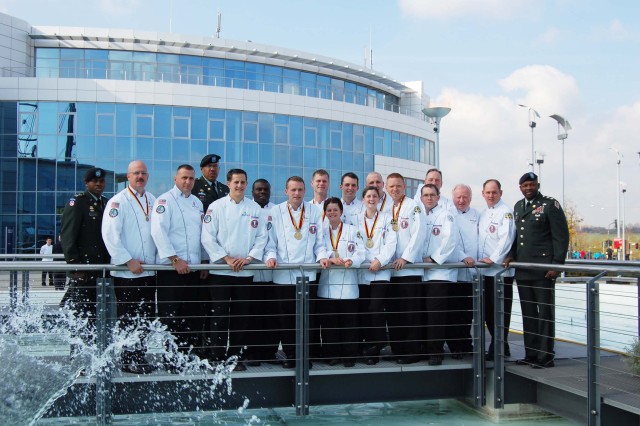In the history of Army cuisine, military chefs have rarely been accused of creating culinary masterpieces. After placing second at the World Culinary Olympics held in Erfurt, Germany, the U.S. Army Culinary Arts Team corrected that misconception.
Hosted by the German Chefs Association, the World Culinary Olympics is the largest culinary exhibition in the world. More than 1,100 chefs from 50 nations divided into regional, national and military teams attended the event.
First-time U.S. Olympians were surprised at the scale of the event. "Any time you enter an arena with the very best, it's a great experience," said Spc. James Jones, USACAT team member. "The shear magnitude of all of it is amazing."
Spicing up the mix, USACAT included members of both the U.S. Coast Guard and U.S. Navy for the first time in its history. As the U.S. military moves more toward a joint-service training environment, USACAT managers were able to select members from the best culinary talent available.
"I was shaky about the camaraderie in the beginning, but I'd take my Army teammates into the Coast Guard any day," said Senior Chief Petty Officer Justin Reed, USACAT team captain.
The primary six competitors at the World Culinary Olympics included Staff Sgt. Steven K. Broome, Spc. Michelle Carville, Sgt. Matthew Flemister, Senior Chief Petty Officer Justin Reed, Staff Sgt. Joshua Spiess and Spc. Valine Vukich.
"Not many people get the chance to represent their country the way we did," said Vukich, USACAT team member. "It's something to be proud of and it was a wonderful experience."
Apprentices were Sgt. Billy Daugette, Coast Guard Petty Officer 2nd Class Edward Fuchs, Spc. James Jones and Staff Sgt. Andre Ward.
"Any position on the team is vital, whether an apprentice or a primary competitor, it takes a team to win," said Fuchs.
The World Culinary Olympics was judged in two parts. The first was the hot-food event in which each team made and served a three-course meal to 150 diners.
For the U.S. Army team, the number of diners increased dramatically when USACAT tickets sold out only 30 minutes after the ticket office opened. Proving USACAT had the recipe for success, diners for a competing military team began requesting the U.S. meal.
"We served at least 175 diners," said Reed.
While you may not find seaweed salad, herb-infused turkey breast or green chocolate mousse crunch cake at an average installation dining facility, they were highlights of the gold-medal- winning hot food meal USACAT served to diners at the event.
The team's menu included seared tuna, smoked trout and poached salmon served over a salad of baby greens dressed in a balsamic vinaigrette with lemon asparagus, seaweed salad, and apple horseradish relish and spiced glazed pecans for the appetizer. For the entrAfAe, herb-infused turkey breast with mushroom stuffing, country sausage, jus lie, sweet potatoes, candied walnut, cooked pears, green beans wrapped with ham, caramelized pearl onions and a cranberry Johnny cake were served. And for dessert, a chocolate mousse crunch cake served with apricot, macerated cherries and chocolate dAfAcor dressed with apricot and cherry sauce.
The second part of the competition was the cold-food event. During the event, competitors spent over a day at an off-site kitchen preparing 21 dishes for a display table in the Olympic exhibition hall. The table is judged for its appearance and each meal is evaluated for presentation and food pairing. For USACAT, the cold-food event immediately followed the hot-food event, leaving them little time to celebrate their gold medal performance.
In 24 hours of non-stop kitchen work, USACAT made, plated and preserved seven, three-course meals. The exhibit table also displayed a white-chocolate tallow sculpture of a Native American on a horse spearing a buffalo, along with other creative dressings unifying the team's 21 dishes under a Native American theme.
World Culinary Olympic judge Connie Anderson appreciated USACAT's presentation. "I immediately wanted to sit down and eat (USACAT's dishes)," he said.
Serving up dishes that delivered, the judges found USACAT worthy of gold for their cold-food presentation.
"I'm ecstatic that everything came together so well. The table was very impressive," said Chief Warrant Officer 4 Robert Sparks, USACAT manager.
Though USACAT received gold medals in both the hot and cold-food events, with a combined score of 183.371, USACAT fell behind Switzerland by six points and placed second. The second-place finish was bittersweet.
"Coming in second isn't what we were there to do-we went to become champions," said Fuchs, USACAT apprentice. "But it's still extraordinary that we came away with second-extraordinary."
USACAT trains at the Army Center of Excellence, Subsistence, Fort Lee, Va. The school trains cooks from all services throughout their careers with advanced individual training, refresher and advanced culinary courses. USACAT represents the finest-trained and most elite of military chefs.
"My hat goes off to the USACAT for what they bring to the Army," said Col. Alexander Davis, Quartermaster Center and School assistant commandant.
USACAT serves as the U.S. National Military Culinary Team and competes at local, national and international culinary competitions. Team members are selected through military competitions and qualifying events.
USACAT members will compete again in March, when they join their installation and service teams for the 34th Annual Culinary Arts Competition at Fort Lee, Va. During the competition, the teams vie for Chef of the Year, Junior Chef of the Year and Installation of the Year titles. Demonstrations, themed display tables, and the knowledge bowl are highlights of the event's public days March 11-12. For the most up-to-date information about the event, visit the Fort Lee Web site, www.lee.army.mil.






Social Sharing